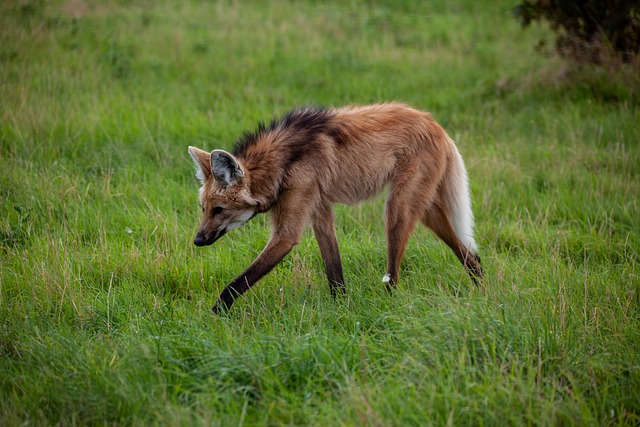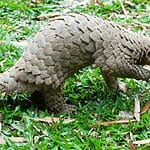The Maned Wolf, also known as Chrysocyon brachyurus is the largest canid in South America. Despite its name, it is not closely related to the Gray Wolf or the coyote.

In fact, it’s actually more closely related to south american bush dogs. It has long reddish fur, a black mane running down its neck and back, and large ears that help in hearing.
The Maned Wolf also has long legs, which give it the appearance of being much taller than it actually is – up to 35 inches at the shoulder. But there’s a lot more about maned which we will discuss in this blog.
Maned Wolf – Facts, Diet, Habitat & Pictures
Appearance
The maned wolf is a species of canid, and their native habitat includes Northern Argentina, South and Central Brazil, Paraguay, Bolivia, and southern Peru and South America.
It is the only large canid with long, reddish fur on its neck and shoulders resembling a mane. Its physical resemblance to red foxes and gray wolves has led some people to mistakenly assume it is a “wolf” or “large fox.”
It has the typical long snout and lanky legs associated with most other canids, though its ears are longer than those of gray wolves, and its skull is more elongated. Its fur is mostly reddish-brown but fades to a creamy color on the belly and inner legs.
Diet
The maned wolf is an omnivore, which means a maned wolf’s diet is based on plants and animals. Its diet consists of fruits and also prey animals that include small birds and small mammals like rabbits, rodents, amphibians, and invertebrates.
The maned wolf also has a unique trait among canids (members of the dog family), which includes gray wolves and coyotes – it is a scavenger. It will often eat carrion or the remains of a dead animal.
Population
It is the largest canine found in its range and has an appearance that resembles a mix between a fox, a coyote, and a gray wolf.
The maned wolves are solitary animals and usually live alone or with a mate, not in packs like wolves. Its population is estimated to be around 17,000 scattered across Central and South America.
Although the maned wolf was once hunted for its fur and meat by humans in its natural range, today, it is a threatened species due to habitat loss.
The species has been included in the endangered species and classified as Threatened Species, but measures are being taken to conserve this unique species. However, the conservation of this species is difficult due to habitat destruction.
Reproduction & Lifespan
In mating season, female maned wolves typically give birth to a litter of two or six pups after a gestation period of 60-65 days.
In the wild, they can live up to 10 years, and in captivity, their lifespan can extend up to 14 years.
Maned wolves are usually monogamous and are known to share territory. And a female-maned wolf and a male-maned wolf only interact for mating.
Incredible Maned Wolf Facts
Maned Wolves have pungent urine.
One interesting adaptation they have is their pungent urine that smells like skunk. This is used to deter other predators, such as coyotes, from invading their territory. It also helps them to find mates during mating season as the smell lingers in the air for miles.
The strong smell of their urine has sulphuric chemicals called hemiterpenoids, usually found in herbs and insect pheromones. Due to its strong urine smell, it is also known as a skunk wolf.
Maned wolves don’t howl.
For communication, the maned wolf uses a long high, pitched whine, and they use it to convey messages to other wolves.
Another sound they use to communicate is roar-bark, a long-distance sound used for defending territory. They dont howl like their relatives, wolves.
Maned wolves are not a wolf or a fox.
Aside from their appearance, the maned wolf is unique, and his ancestry, comes from extinct dogs that are called canids. And it is a member of its group.
They eat their Puke.
Whenever the wolf pups are hungry, they ask for food from their parents, and this feeding behavior is common in birds. With all these animals, maned wolves are also included in it.
In this feeding behavior of animals, one parent takes out the digested food to feed its young ones, and this process is known as regurgitating.
And a male-maned wolf often performs this duty more than a female-maned wolf. Which is why they have more strong bonds and connections with the pups.
Not even in the Wild, but in zoological settings, male maned wolves usually regurgitate food for their young ones. This shows that a male plays an important part in raising their pups.
Conservation efforts for maned wolves
For the last 30 years, the Smithsonian National Zoo Park has been working to protect maned wolves from reaching the brink of extinction.
Smithson is working on an interzoo maned wolf Species Survival Plan for North America, which includes breeding maned wolves, researching wild maned wolves, finding ways to protect their habitat, and spreading awareness about the importance of maned for our ecological system.
Conclusion
The maned wolf is not closely related to wolves. However, they belong to the south american bush dogs. It got maned in his name from a blackish mane with large ears coming down from his neck.
Moreover, they don’t howl like their cousins. They feed their pups through puking and have a strong urine smell.
Additionally, the IUNC marked this species as a near-threatened species due to their habitat loss and illegal hunting. Presently there are around 17 thousand maned wolves in the world. Check out the video given below for more information about maned wolves.
Frequently Asked Questions
What is a maned wolf a mix of?
Maned wolf belongs to extinct other dogs, and they are not a mixed breed of fox and wolf.
Is a maned wolf a dog?
The maned wolf is a member of the Canidae family.
Why is it called a maned wolf?
A maned wolf has a mane on its neck, erected when it senses danger.
Is a maned wolf a wolf or a fox?
Genetic research proved that it is a different species. It is neither a dog nor a wolf.









